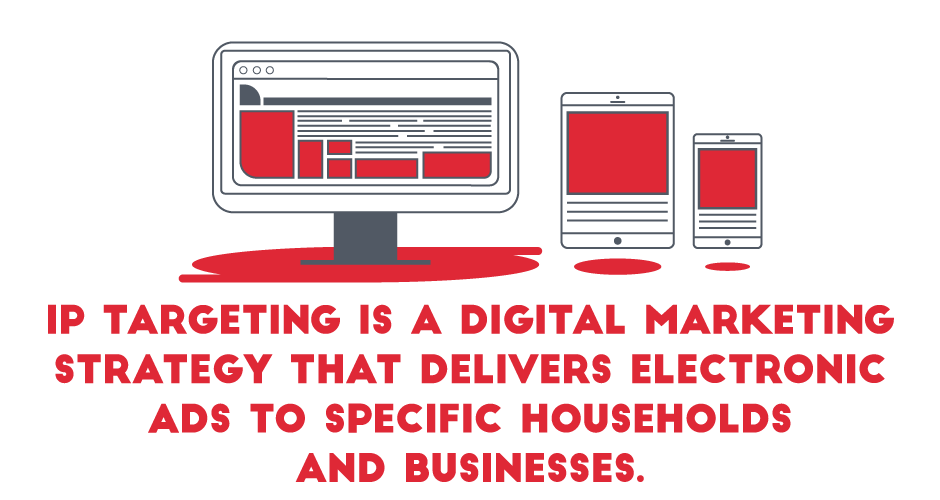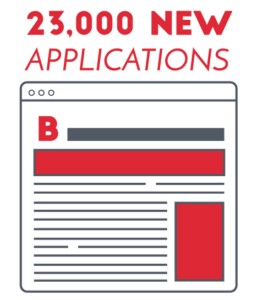
0
Cold calling, blind emails, and direct mail pieces are all outdated marketing strategies. In 2007, you needed to contact a prospect an average of 3.68 times. However, due to the abundance of smartphones, tablets, and spam filters, the average number of contact attempts increased to 8-12 times.

IP targeting does not use any cookies in determining IP addresses, meaning your message reaches real households, and not bots. Every time your prospect goes online, we identify their IP address and serve them an ad. Our IP targeting technology is able to identify street addresses and determine IP addresses at a 95% surety.
Colleges and universities, regardless of size, successfully utilize IP targeting to attract new students each year. By sending highly targeted, personalized ads to students, schools can increase their enrollment. Recently, we launched an IP targeting campaign to help a university in Massachusetts attract prospective students. The university’s current marketing campaign focused on direct mail, campus tours and visits, information sessions, and a calling campaign. Our goal was to help increase international student enrollment, as well as increase enrollment rates in comparison to other universities in their market area. We were able to help this university increase their enrollment by 8% in 5 months.
Step 1 Build A Target List
 Every device that is connected to the internet has an IP address, which represents the physical location of that device. By using the university’s pre existing mailing list, we matched these street addresses to a list of IP addresses. We focused on targeting students at a household level.
Every device that is connected to the internet has an IP address, which represents the physical location of that device. By using the university’s pre existing mailing list, we matched these street addresses to a list of IP addresses. We focused on targeting students at a household level.
Our IP targeting campaign focused on specific households of our intended audience. We utilized the university’s current mailing list to filter alumni data. By focusing on the households, we were able to see which alumni members had children between the ages of 16-18. We sent these households advertisements in hopes that they would attend the university in the future.
Next, we targeted homes of students, that hadn’t applied, based on their standardized test scores, demographic, religion, and high school graduation date. We were able to extend the ad further, and send students ads that provided scholarship offers based on their test scores.
Lastly, we collected addresses from applications of students who applied, but had not officially accepted the university’s invitation. After compiling the addresses and matching them to IP addresses, we sent these students personalized advertisements. These ads focused on how the university was excited for students to be a part of their family and culture.
Step 2 Discovery & Strategy Discussion
with the Client
 Through the process of discovery, we revealed the university’s goals, strengths, and weaknesses. We identified their competition, specific problem areas, their point of difference, and ultimately obtained a sense of their identity and brand.
Through the process of discovery, we revealed the university’s goals, strengths, and weaknesses. We identified their competition, specific problem areas, their point of difference, and ultimately obtained a sense of their identity and brand.
After learning all we could about the university, we drafted potential creative messaging to send to prospective students. Using the university’s current student mailing list, we mapped the IP addresses of roughly half of the students.
Step 3 Discovery Testing
 After drafting two different versions of our creative messages, we decided to A/B test the messages on a portion of the targeted students. The targeted students received their acceptance letters from the university, but had not yet accepted. By employing A/B testing, our goal was to determine which message would be better suited to attract students. We focused on a small portion students from our original targeted group; Half of the students received Message A, and the other half received Message B.
After drafting two different versions of our creative messages, we decided to A/B test the messages on a portion of the targeted students. The targeted students received their acceptance letters from the university, but had not yet accepted. By employing A/B testing, our goal was to determine which message would be better suited to attract students. We focused on a small portion students from our original targeted group; Half of the students received Message A, and the other half received Message B.
Message A was our Acceptance Letter Campaign. This campaign focused on the students’ acceptance letters. The goal of Message A was to remind students that they had not yet accepted or rejected the university’s invitation to attend.
Message B was our Accepted Students Event Campaign. This campaign served as an invitation to students. It invited students and their families to the campus in order to enjoy a free concert from a popular band.
After the campaign, we discovered that Message B received more positive interaction and feedback from targeted students than Message A.
Results
 Upon seeing the success of Message B, we launched a full scale IP targeting campaign, in addition to the university’s current marketing campaign. Within 90 days, the university saw an 8% lift in their total enrollment. In turn, this lift resulted in 23,000 new applications for the university’s fall semester. This combined campaign targeted households of students who were likely to apply, based on their ACT/SAT scores, location, and high school graduation date. The marketing cost of the 23,000 new applications cost the university 50% less than the cost of the direct mail and email campaign.
Upon seeing the success of Message B, we launched a full scale IP targeting campaign, in addition to the university’s current marketing campaign. Within 90 days, the university saw an 8% lift in their total enrollment. In turn, this lift resulted in 23,000 new applications for the university’s fall semester. This combined campaign targeted households of students who were likely to apply, based on their ACT/SAT scores, location, and high school graduation date. The marketing cost of the 23,000 new applications cost the university 50% less than the cost of the direct mail and email campaign.
Increasing student enrollment can be an ongoing issue for universities and colleges. While Many universities launch email and direct mail campaigns in order to reach prospective students, only a small portion of schools employ IP targeting. Students that receive highly personalized IP targeted ads from a university are 35% more likely to apply for admission, than students who only received email and direct mail ads.

Off